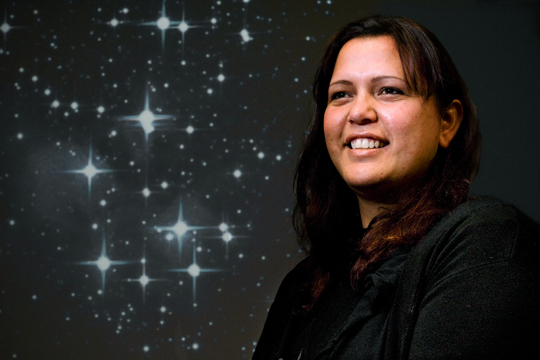Modern Uses for Ancient Māori Knowledge

Identifying modern-day uses for ancient Māori knowledge of the sun, moon and stars is one goal of research led by Victoria University astrophysicist Dr Pauline Harris.
The Victoria post-doctoral fellow chairs a national research group called the Society of Māori Astronomy Research and Traditions (SMART) which is carrying out a New Zealand-wide study on Māori astronomy.
The team is looking at topics such as traditional celestial navigation and the 'star paths' Māori took to travel between islands and the use of tribal moon calendars to plant crops and fish at favourable times of the year.
Dr Harris, of Rongomaiwahine and Ngāti Kahungunu descent, has spent the last year forming a picture of how particular tribes developed calendars from the movement of the moon, using published and unpublished materials and interviewing iwi.
Her findings will be released later this year but, as part of Matariki celebrations, she will share some of her insights at a public lecture at Wellington’s Carter Observatory on 19 June.
Tohunga whakairo (master carver) Dr Takirirangi Smith and traditional knowledge expert Toa Waaka will join Dr Harris’s presentation. The trio will talk about how Māori used moon calendars, called maramataka, to track time, plant and harvest crops, fish and hold festivals.
Dr Harris says Matariki is a prime example of how some tribes used the moon and stars to mark the New Year and to celebrate and remember people who had died.
She says groups like SMART are able to meet the increasing appetite for information about Māori astronomy.
"Our role is to collate, preserve and revitalise traditional knowledge and share it with iwi, in the first instance, and the wider public over time.
"Ultimately, we want New Zealanders to have access to two valuable knowledge systems – the matauranga Māori system and the Western system – and to celebrate and use both."
In time, says Dr Harris, the group’s research will have a wide range of applications.
It will contribute to the ongoing cultural renaissance and resurgence of Māori identity by ensuring Māori communities know and understand more about traditional astronomy knowledge and practices – and can apply it to their daily lives.
It will also be developed into education resources such as books and outreach programmes for primary and secondary school students.
Additionally, it may also help global organisations, such as UNESCO, that want long-term, in-depth data from around the world to better understand the relationship between calendars used by indigenous cultures and climate change.
